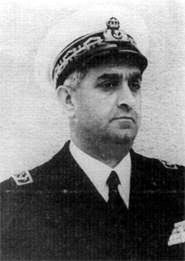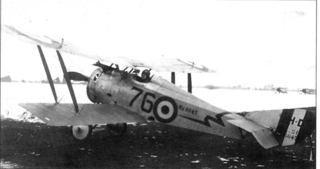
The Italian Corpo Aeronautico Militare was formed as part of the Regio Esercito on 7 January 1915, incorporating the Aviators Flights Battalion (airplanes), the Specialists Battalion (airships) and the Ballonists Battalion. Prior to World War I, Italy had pioneered military aviation in the Italo-Turkish War during 1911–1912. Its army also contained one of the world's foremost theorists about the future of military aviation, Giulio Douhet; Douhet also had a practical side, as he was largely responsible for the development of Italy's Caproni bombers starting in 1913. Italy also had the advantage of a delayed entry into World War I, not starting the fight until 24 May 1915, but took no advantage of it so far as aviation was concerned.

Sottotenente Michele Allasia was a World War I fighter ace credited with five aerial victories.
Sottotenente de Vascello Umberto Calvello was a World War I fighter ace credited with five victories.
Capitano Giulio Lega was a World War I flying ace credited with five aerial victories. After finishing the war, he completed medical school, and began a near lifelong career caring for the Italian Chamber of Deputies.

Federico Carlo Martinengo was an Italian flying ace, credited with five aerial victories, during World War I, and an Italian admiral during World War II.
Tenente Giovanni Sabelli was an Italian World War I flying ace credited with five aerial victories. At the start of World War I, he was already an experienced combat pilot.

Tenente ColonnelloAlessandro Buzio was an Italian World War I flying ace credited with six aerial victories, four of them shared.

Tenente Luigi Olivi (1894–1917) was an Italian World War I flying ace credited with six aerial victories. He won two awards of the Silver Medal for Military Valor and was killed in action.

TenenteMario Fucini was a World War I flying ace who claimed credit for 13 aerial victories during the war; seven of these were confirmed in 1919.

Tenente di VascelloOrazio Pierozzi (1884–1919) was a World War I flying ace credited with seven aerial victories.
TenenteLuigi Olivari was a World War I flying ace who claimed 19 aerial victories. His Spad VII stalled into a fatal crash on 13 October 1917. Posthumously, he was awarded credit for eight aerial victories.
Tenente Gastone Novelli was a World War I flying ace credited with eight aerial victories.

LieutenantGiovanni 'Giannino' Ancillotto was an Italian World War I flying ace credited with 11 confirmed aerial victories. Rather unusually, he served solely with aviation while he was in the military, beginning in the lowest rank. Among his aerial victories as a fighter pilot were three over enemy observation balloons right after the Battle of Caporetto. As an example of the hazards of balloon busting, on 5 December 1917 Ancillotto returned to base with singed swatches of the third balloon's fabric adhering to his damaged fighter plane.

71a Squadriglia of the Corpo Aeronautico Militare was one of the original fighter squadrons of the Italian military. Founded on 30 January 1916 to fight in World War I, the squadron served until war's end. It flew almost 3,000 combat sorties in defense of Italy at a cost of six pilots killed, scored 17 victories, and produced two aces from its ranks.

76a Squadriglia of the Corpo Aeronautico Militare was one of Italy's original fighter squadrons, being founded during World War I on 25 May 1916. On 30 May 1916, the new unit began its combat career. Between 22 April and 3 October 1917, three of its commanding officers became casualties. It was drawn into the air fighting over Caporetto in late 1917, and forced to retreat three times during November as a consequence of the Italian defeat.
77a Squadriglia was one of the first Italian fighter squadrons. After its founding on 31 May 1916, it began flying combat in July 1916, and would operate until the end of World War I. It was one of the squadrons drawn into late 1917's Battle of Caporetto, and forced to retreat after the Italian defeat. By the time the Austro-Hungarians sued for peace, 77a Squadriglia could count some 50 aerial victories scored in about 250 victories.
79a Squadriglia was one of Italy's first fighter squadrons. It served in combat during World War I from 13 January 1917 though war's end. It was credited with 47 aerial victories.

80a Squadriglia was an Italian fighter squadron founded in 1917 to serve in support of the Battles of the Isonzo in northern Italy. By war's end, it had been credited with 21 aerial victories without suffering any of its own personnel casualties.

81a Squadriglia was an Italian fighter squadron raised in March 1917 that served through the end of World War I. One of its aces, Flavio Baracchini, would become the first awardee of the Gold Medal for Military Valor. The squadron would be credited with 34 aerial victories, and suffer four dead. It ended the war with 28 aircraft on strength.

Squadriglia 91a was one of the later fighter squadrons that the Italian Army created, on 1 May 1917. Because it drew an experienced cadre of pilots from pre-existing 70a Squadriglia, the squadron scored 14 victories within its first month of flying combat. As a result, it became known as "the squadron of aces". The new unit was immediately drawn into the ongoing Battles of the Isonzo in northern Italy. In September 1917, the squadron would serve as test pilots of the universally condemned SIA 7 multipurpose aircraft.












